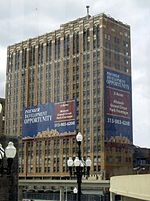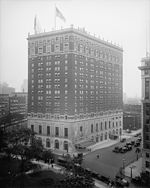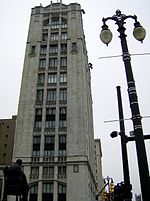Hotel Tuller
1906 establishments in Michigan1976 disestablishments in MichiganBuildings and structures demolished in 1991Demolished buildings and structures in DetroitDemolished hotels in the United States ... and 6 more
Historic district contributing properties in MichiganHotel buildings completed in 1906Hotel buildings on the National Register of Historic Places in MichiganNRHP infobox with nocatNational Register of Historic Places in DetroitUse mdy dates from August 2023

The Hotel Tuller once stood at Adams Avenue West, Bagley Street, and Park Avenue across from Grand Circus Park in downtown Detroit, Michigan. It was one of the largest luxury hotels in Detroit, and the first one to be erected in the Grand Circus Park Historic District. The hotel was known as the "grand dame of Grand Circus Park." The site is now the location of a parking lot next to the United Artists Theatre Building. Composer Gerald Marks' band, the Gerald Marks's Hotel Tuller Orchestra, was based at the hotel. The band made several commercially successful recordings for Columbia Records in the mid-1920s.
Excerpt from the Wikipedia article Hotel Tuller (License: CC BY-SA 3.0, Authors, Images).Hotel Tuller
Park Avenue, Detroit
Geographical coordinates (GPS) Address Nearby Places Show on map
Geographical coordinates (GPS)
| Latitude | Longitude |
|---|---|
| N 42.3361 ° | E -83.0522 ° |
Address
Park Avenue & Bagley Street
Park Avenue
48201 Detroit
Michigan, United States
Open on Google Maps









